Key takeaways:
- Home energy management optimizes energy consumption and monitoring, leading to cost savings and reduced carbon footprint.
- Implementing smart devices and systems enhances control over energy use and allows for real-time monitoring of consumption patterns.
- Conducting an energy audit and using energy-efficient appliances can significantly lower bills and improve overall home comfort.
- Investing in smart home technology, like smart thermostats and lighting, increases efficiency and promotes mindful energy usage.
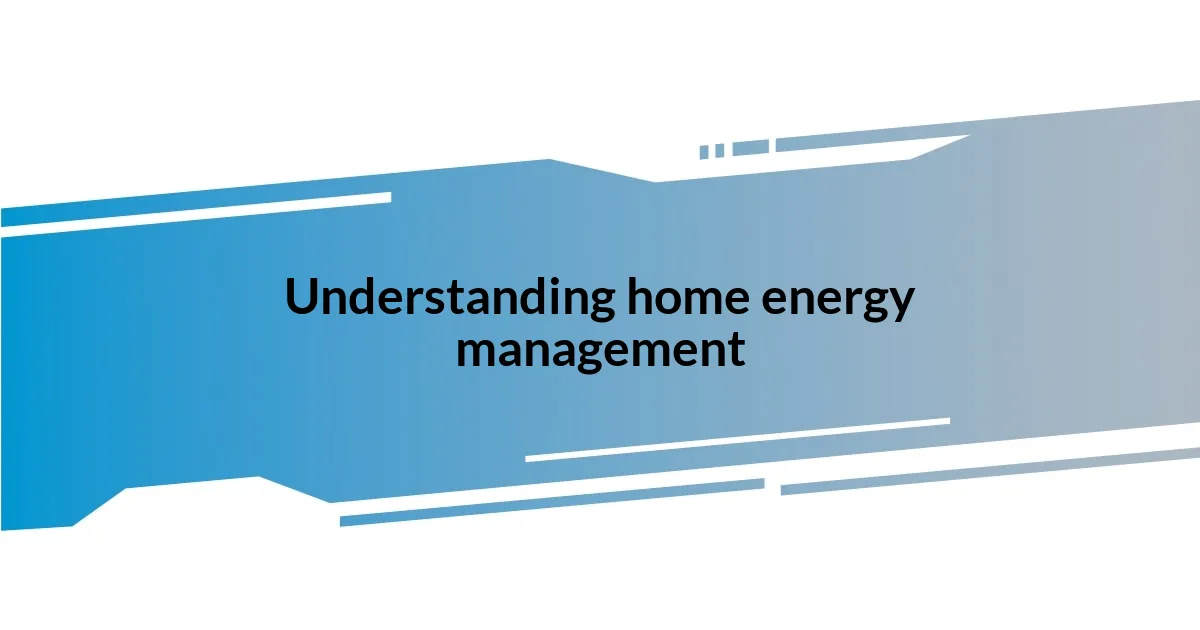
Understanding home energy management
Home energy management is all about optimizing how we consume and monitor the energy in our homes. I remember when I first became aware of my energy use; I was shocked to see how much my old appliances were costing me. It made me wonder, have you ever considered how small changes in your habits could lead to significant savings?
At its core, effective energy management requires a blend of awareness and action. Imagine if you could track your energy consumption in real time—how empowering would that be? By leveraging smart devices and tools, you can identify patterns and make informed decisions that not only lower your bills but also reduce your carbon footprint.
I’ve found that understanding energy management isn’t just about saving money; it’s about creating a more sustainable lifestyle. For example, I started unplugging my devices when not in use, and it felt great to see my energy usage drop. Have you ever taken inventory of what’s actually running in the background at your home? It might surprise you!
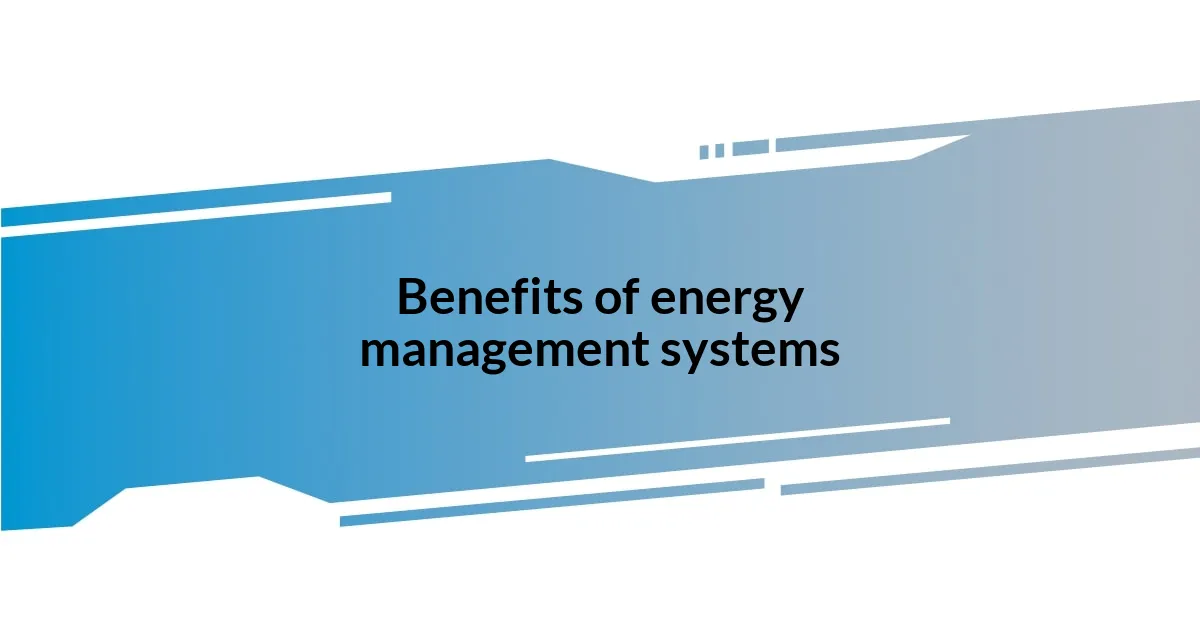
Benefits of energy management systems
Implementing an energy management system in your home can feel like a game-changer. When I first installed a smart thermostat, I was surprised by how much control I gained over my energy consumption. Suddenly, I could adjust the temperature from my phone while I was out. This simple upgrade led to a noticeable reduction in my energy bill, and I loved seeing my efforts translate into real savings.
Here are some key benefits of energy management systems:
- Cost Savings: Reducing unnecessary power usage directly lowers your energy bills.
- Real-time Monitoring: You gain insights into your consumption patterns, helping you identify areas for improvement.
- Increased Home Comfort: By optimizing heating and cooling, you create a more pleasant living environment.
- Carbon Footprint Reduction: Efficient energy use contributes to a healthier planet.
- Enhanced Control: Smart devices give you flexibility in managing your home’s energy use from anywhere.
In my experience, taking the initiative to manage energy effectively not only benefits my finances but also fosters a deeper sense of responsibility toward the environment. Knowing that my small actions contribute to a larger, positive impact has made this journey incredibly fulfilling.
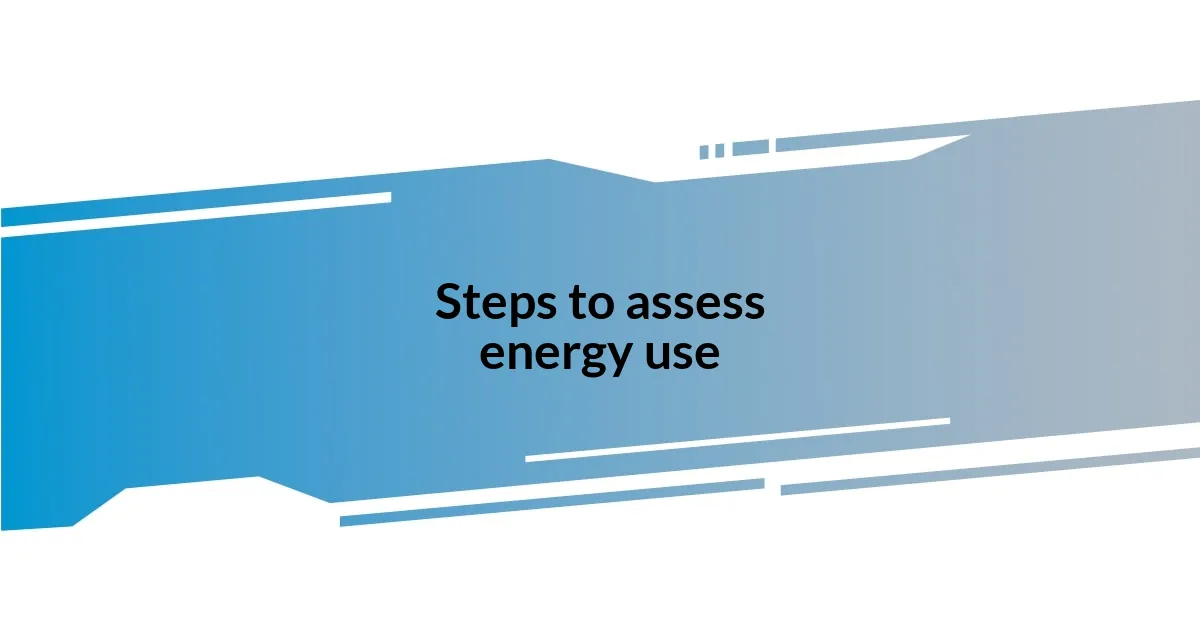
Steps to assess energy use
To effectively assess energy use in your home, the first step is to conduct a simple energy audit. I remember the first time I did this; I was amazed at how much energy my favorite devices consumed, even when not in use. You can start by looking at your utility bills and identifying usage patterns over a few months. This approach not only reveals peak consumption times but also helps highlight any unusually high costs. Have you ever noticed those dramatic spikes in your bills during certain months?
Next, I suggest listing all your appliances and their energy ratings. It was eye-opening for me to see the differences in energy consumption among my devices. You might be surprised to find that some older appliances use significantly more energy than their modern counterparts. This step isn’t just about numbers; it’s about understanding how each item in your home contributes to your overall energy footprint.
Finally, consider using energy monitoring tools or smart devices to get a real-time glimpse into your energy usage. I’ve found that these devices can be incredibly motivational; seeing live data on my energy habits truly pushed me toward more mindful consumption. By tracking your usage patterns over time, you can pinpoint areas for improvement and make informed decisions that resulting in tangible benefits to your wallet and the environment.
| Step | Description |
|---|---|
| Energy Audit | Review your utility bills to identify usage patterns. |
| Appliance Inventory | List appliances and their energy consumption ratings. |
| Real-time Monitoring | Use smart devices to track current energy usage. |
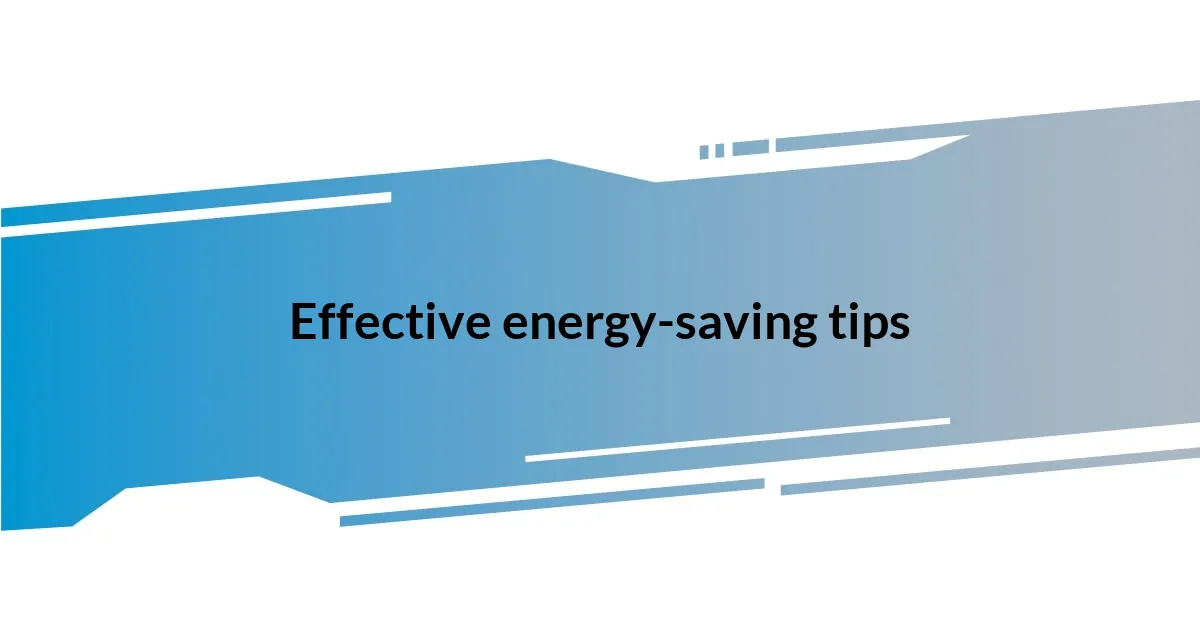
Effective energy-saving tips
One of the most effective energy-saving tips I’ve embraced is simply being mindful of my lighting. I remember a time when I’d leave lights on in every room without a second thought. Now, I try to switch to LED bulbs and make a habit of turning off lights when I leave a room. It might seem minor, but every little change adds up—sometimes, I look at my bill and can’t help but smile knowing that a small act has contributed to savings.
Additionally, I’ve learned the importance of unplugging devices when they’re not in use, especially when it comes to chargers and electronics. Do you really need all those items plugged in all the time? When I started unplugging, it truly opened my eyes to how much energy was quietly being wasted. It’s almost like a mini cleanse for my home! Now, I take pride in knowing I’m not only saving money but also being kinder to the planet.
Another tip I swear by is to optimize your heating and cooling systems. Winter used to mean cranking up the thermostat, but I’ve since started using draft stoppers and sealing windows. It feels great to know that I can maintain comfort without overworking my furnace. What about you? Have you noticed a difference just by being a bit more proactive? It’s all about finding those little adjustments that make a big impact, and believe me, every bit counts in the quest for efficient energy use.
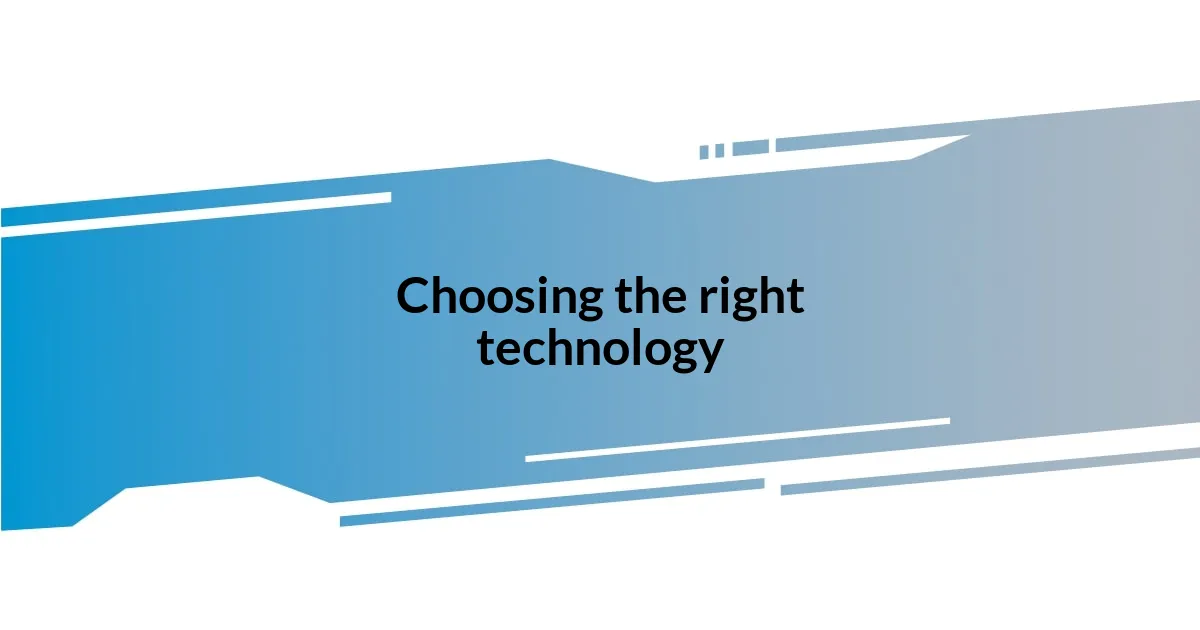
Choosing the right technology
When it comes to choosing the right technology for home energy management, I often recommend starting with energy-efficient appliances. A few years back, I replaced my old refrigerator with an Energy Star-rated model, and the difference has been remarkable. Have you ever calculated how much a newer appliance can save you each month? Trust me, it’s worth it when you see your bills drop, and knowing that I’m contributing to a healthier planet feels rewarding.
Smart home devices are another excellent consideration. I remember installing a smart thermostat; it adjusted my heating based on my habits and saved me a ton without me having to lift a finger. Have you thought about how much energy you could save with just a small investment in technology? It’s fascinating to think about the ways these gadgets can learn from your behavior, making your home more efficient while seamlessly fitting into your lifestyle.
Lastly, think about incorporating renewable energy technologies, like solar panels. The day my panels went live was a game changer—I felt like I was finally taking a real step toward energy independence. If you’ve ever wondered how much freedom comes with generating your own energy, let me tell you: it’s liberating. Plus, there are often incentives now that can make these investments more accessible than ever. Hang on to that thought; finding a technology that aligns with your energy goals can fundamentally transform your home’s sustainability.
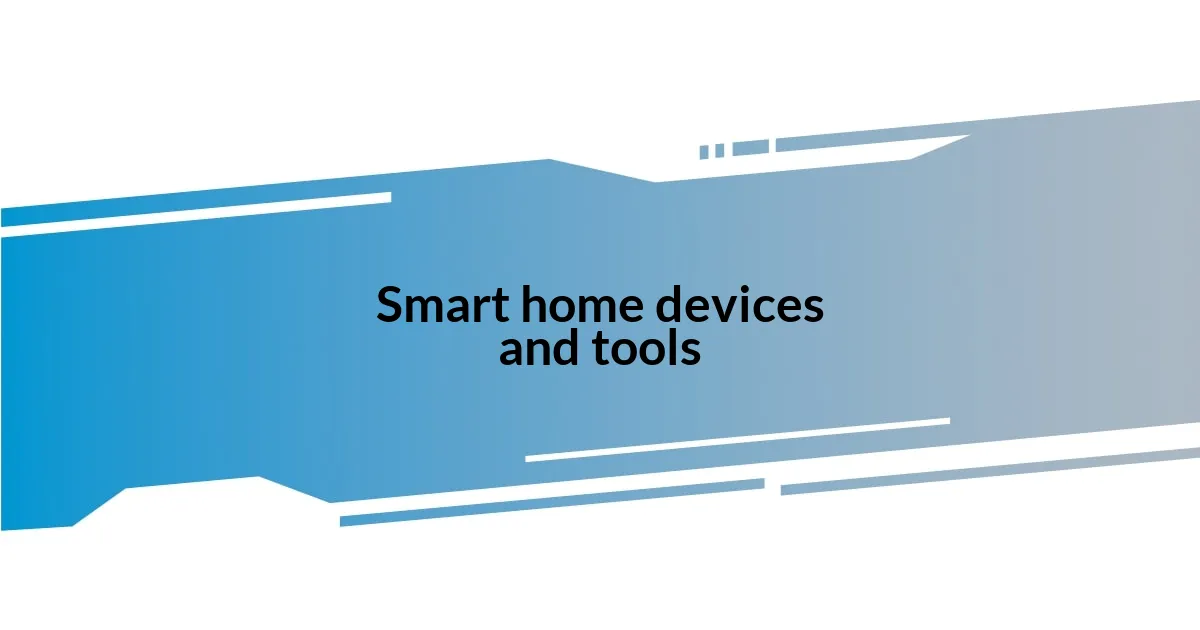
Smart home devices and tools
Investing in smart home devices has transformed my approach to energy management. For instance, I set up smart plugs for my kitchen appliances, allowing me to monitor and control energy usage right from my phone. Have you ever been at work, wondering if you left your toaster plugged in? Now, I can check and turn it off remotely, and it genuinely gives me peace of mind.
Another delightful surprise was when I added smart lighting to my home. At first, it felt like an indulgence, but I quickly realized how much I enjoy programming the lights to dim at night and brighten in the morning. It’s remarkable how these little adjustments can create the perfect ambiance while saving energy. Have you experienced the joy of walking into a perfectly lit room—no switches required?
One of my proudest moments was installing a smart thermostat that learned my daily routine. I love how it automatically adjusts the temperature based on my comings and goings, and it keeps my house cozy while minimizing energy waste. Isn’t it fascinating how technology can feel almost like it knows you? This level of automation has alleviated my worry about energy bills, and instead of stressing over costs, I’m now focused on enjoying my home.
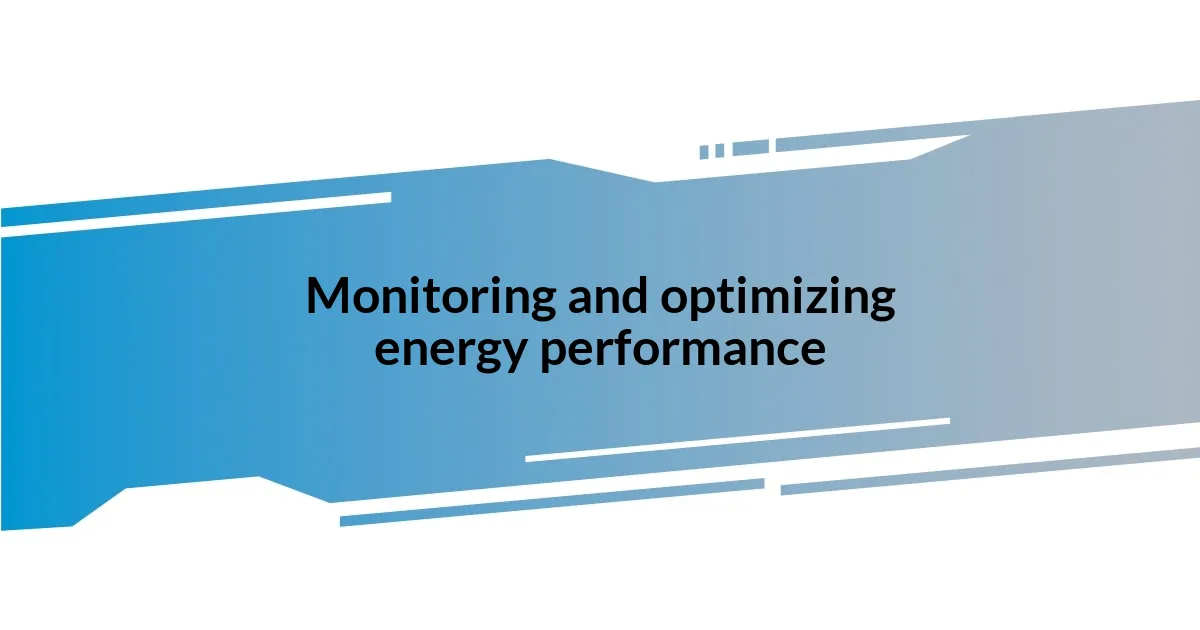
Monitoring and optimizing energy performance
I’ve found that monitoring energy performance often begins with tracking my energy consumption over time. Using a simple app on my phone, I can see how my energy use fluctuates with changing seasons. Have you ever noticed how much more energy you burn in the colder months? This real-time feedback helps me make informed decisions about when to use certain appliances, and I can’t stress enough how empowering it feels to take control of my energy usage.
Diving deeper into optimizing my energy performance, I decided to conduct a quick energy audit at home. It was surprisingly eye-opening to pinpoint those simple drafts and underused areas that wasted power. Finding and sealing those gaps not only makes my home feel cozier but also directly translates into savings. It’s like discovering hidden treasures in your own space—who wouldn’t want to save money while enjoying a snug environment?
Moreover, I switched to using energy monitoring devices that provide real-time data on my habits. Just last month, I was shocked to discover that my home office setup was running more than I thought. By adjusting my usage patterns based on this data, I managed to save a nice chunk of change on my bill. What if you could see exactly where your energy was going? It’s incredible how this newfound awareness shifts my perspective on consumption, making me more intentional about how I use energy each day.